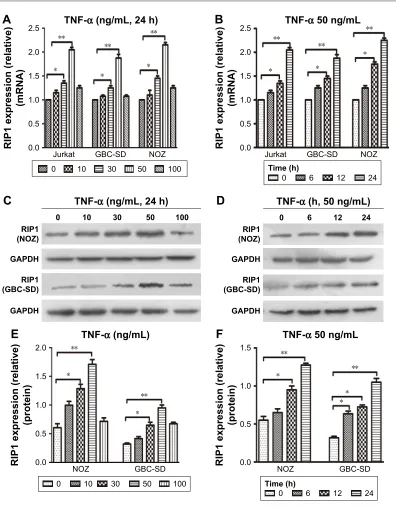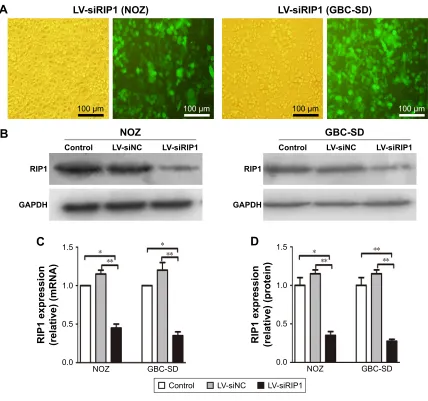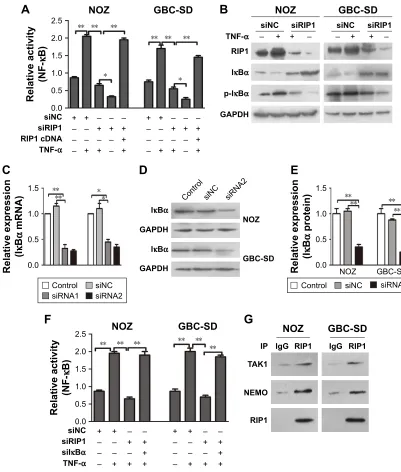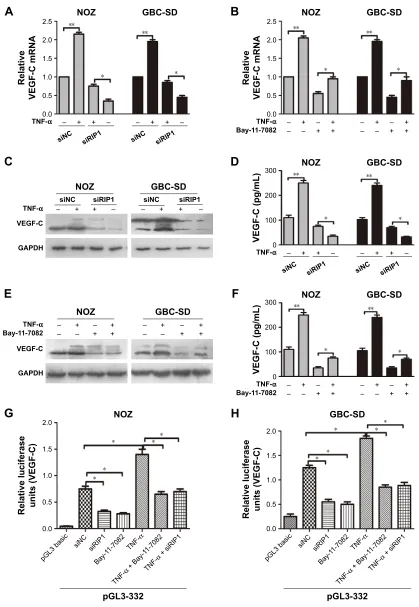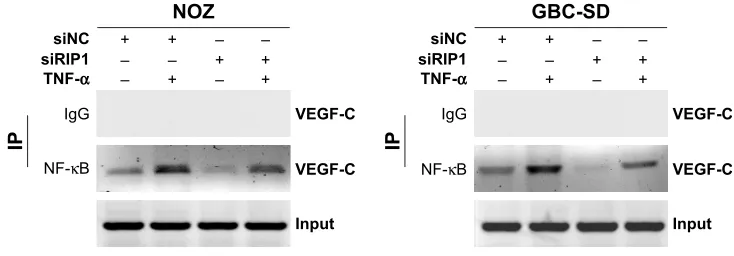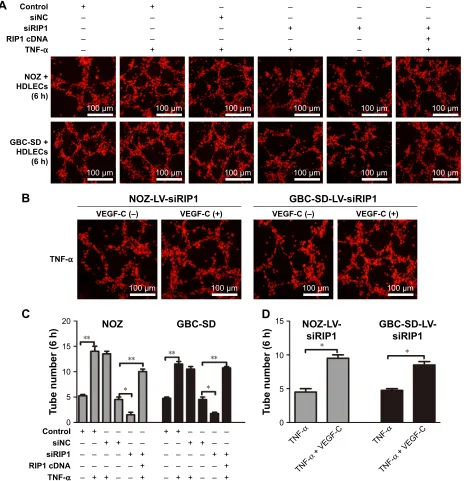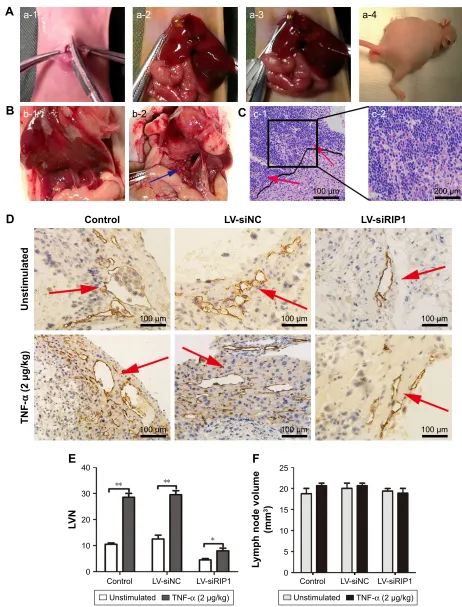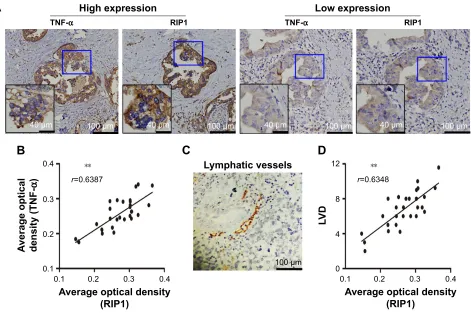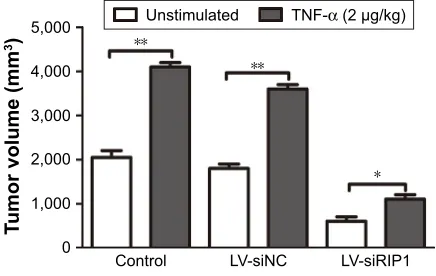OncoTargets and Therapy 2018:11 2875–2890
OncoTargets and Therapy
Dove
press
submit your manuscript | www.dovepress.com 2875
O r i g i n a l r e s e a r c h
open access to scientific and medical research
Open access Full Text article
riP1 regulates TnF-
α
-mediated lymphangiogenesis
and lymphatic metastasis in gallbladder cancer by
modulating the nF-
κ
B-VegF-c pathway
cheng-Zong li,1–3,* Xiao-Jie
Jiang,1,2,* Bin lin,1,2 hai-Jie
hong,1,2 si-Yuan Zhu,1,2 lei
Jiang,1,2 Xiao-Qian Wang,1
nan-hong Tang,1 Fei-Fei
she,2 Yan-ling chen1,2
1Department of hepatobiliary surgery
and Fujian institute of hepatobiliary surgery, Fujian Medical University Union hospital, Fuzhou, People’s republic of china; 2Key laboratory
of the Ministry of education for gastrointestinal cancer and Key laboratory of Tumour Microbiology, school of Basic Medical sciences, Fujian Medical University, Fuzhou, People’s republic of china;
3Department of general surgery,
The second affiliated hospital Of Fujian Medical University, Quanzhou, People’s republic of china
*These authors contributed equally to this work
Background: Tumor necrosis factor alpha (TNF-α) enhances lymphangiogenesis in gallblad-der carcinoma (GBC) via activation of nuclear factor (NF-κB)-dependent vascular endothelial growth factor-C (VEGF-C). Receptor-interacting protein 1 (RIP1) is a multifunctional protein in the TNF-α signaling pathway and is highly expressed in GBC. However, whether RIP1 participates in the signaling pathway of TNF-α-mediated VEGF-C expression that enhances lymphangiogenesis in GBC remains unclear.
Methods: The RIP1 protein levels in the GBC-SD and NOZ cells upon stimulation with increas-ing concentrations of TNF-α as indicated was examined usincreas-ing Western blot. Lentiviral RIP1 shRNA and siIκBα were constructed and transduced respectively them into NOZ and GBC-SD cells, and then PcDNA3.1-RIP1 vectors was transduced into siRIP1 cell lines to reverse RIP1 expression. The protein expression of RIP1, inhibitor of NF-κB alpha (IκBα), p-IκBα, TAK1, NF-κB essential modulator were examined through immunoblotting or immunoprecipitation. Moreover, VEGF-C mRNA levels were measured by quantitative real-time polymerase chain reaction, VEGF-C protein levels were measured by immunoblotting and enzyme-linked immu-nosorbent assay, and VEGF-C promoter and NF-κB activities were quantified using a dual luciferase reporter assay. The association of NF-κB with the VEGF-C promoter was analysed by chromatin immunoprecipitation assay. A three-dimensional coculture method and orthotopic transplantation nude mice model were used to evaluate lymphatic tube-forming and metastasis ability in GBC cells. The expression of RIP1 protein, TNF-α protein and lymphatic vessels in human GBC tissues was examined by immunohistochemistry, and the dependence between RIP1 protein with TNF-α protein and lymphatic vessel density was analysed.
Results: TNF-α dose- and time-dependently increased RIP1 protein expression in the GBC-SD and NOZ cells of GBC, and the strongest effect was observed with a concentration of 50 ng/ml. RIP1 is fundamental for TNF-α-mediated NF-κB activation in GBC cells and can regulate TNF-α-mediated VEGF-C expression at the protein and transcriptional levels through the NF-κB pathway. RIP1 can regulate TNF-α-mediated lymphatic tube formation and metastasis in GBC cells both in vitro and vivo. The average optical density of RIP1 was linearly related to that of TNF-α protein and the lymphatic vessel density in GBC tissues.
Conclusion: We conclude that RIP1 regulates TNF-α-mediated lymphangiogenesis and lymph node metastasis in GBC by modulating the NF-κB-VEGF-C pathway.
Keywords: gallbladder cancer, RIP1, TNF-α, NF-κB, VEGF-C, lymphangiogenesis
Introduction
Gallbladder cancer (GBC) is a relatively infrequent but fatal disease, and ,10% of cases
have the opportunity to undergo surgical treatment.1 Moreover, the overall 5-year
sur-vival rate is ,5%.2 This malignancy exhibits a propensity for lymphatic metastasis; the
correspondence: Yan-ling chen Department of hepatobiliary surgery and Fujian institute of hepatobiliary surgery, Fujian Medical University Union hospital, 29 Xinquan road, Fuzhou 350001, People’s republic of china Tel +86 133 6591 0368 Fax +86 591 8711 3828 email ylchen@medmail.com.cn
Fei-Fei she
Key laboratory of Ministry of education for gastrointestinal cancer and Key laboratory of Tumour Microbiology, school of Basic Medical sciences, Fujian Medical University, 1 Xueyuan road, Minhou, Fuzhou 350108,
People’s republic of china Tel +86 135 1406 3583 Fax +86 591 2286 2112 email shefeifei@yeah.net
Journal name: OncoTargets and Therapy Article Designation: Original Research Year: 2018
Volume: 11
Running head verso: Li et al
Running head recto: RIP1 regulates TNF-α-mediated lymphangiogenesis in gallbladder cancer DOI: 159026
OncoTargets and Therapy downloaded from https://www.dovepress.com/ by 118.70.13.36 on 25-Aug-2020
For personal use only.
Dovepress li et al
incidence of regional lymphatic metastasis at stages II and III/
IV is in the range of 19%–62% and 75%–85%, respectively.1,3,4
Thus, lymph node metastasis (LNM) serves as a significant
factor in the prognosis of GBC.5 However, the mechanism of
lymphatic metastasis in GBC is poorly understood.
Studies have confirmed that cancer development and
pro-gression are closely associated with chronic inflammation.6
We previously reported that tumor necrosis factor alpha
(TNF-α), a well-characterized proinflammatory factor,
can activate nuclear factor (NF)-κB-dependent vascular
endothelial growth factor-C (VEGF-C) to enhance
lymp-hangiogenesis in GBC.7,8 However, the signaling
path-ways that participate in the TNF-α-mediated activation of
NF-κB-dependent VEGF-C are complicated.9–11 Therefore,
elucidating the precise molecular mechanism underlying
TNF-α-mediated lymphatic signaling is critical for the
clini-cal treatment of lymphatic metastasis in GBC.
TNF-α can activate death receptors such as TNF-α
receptor 1 (TNFR1) and TNF-α receptor 2 (TNFR2).12 Upon
stimulation of TNFR1, receptor-interacting protein 1 (RIP1) forms a complex with other proteins and factors referred to
as Complex I.13,14 Furthermore, RIP1 acts as a scaffold for
combination with NF-κB essential modulator (NEMO),
transforming growth factor beta (TGFβ)-activated kinase 1
(TAK1), and the TAK1-binding proteins TAB1 and TAB2,
which leads to phosphorylation of inhibitor of NF-κB alpha
(IκBα), as well as degradation and induction of NF-κ
B-dependent genetic transcription.15 However, whether RIP1
participates in the signaling pathways associated with TNF-α
-mediated VEGF-C expression leading to the enhancement of lymphangiogenesis in GBC remains unclear.
In the present study, TNF-α dose and time dependently
increased RIP1 mRNA and protein expression in the human GBC cell lines GBC-SD and NOZ. RIP1 was essential for
TNF-α-mediated NF-κB activation and could regulate TNF-α
-mediated VEGF-C expression at the protein and transcriptional
levels through the NF-κB pathway in GBC cells. Subsequently,
we showed that RIP1 could regulate TNF-α-mediated
lymp-hangiogenesis and lymphatic metastasis in vivo and ex vivo. Finally, our findings confirmed that expression of the RIP1
protein was linearly associated with that of the TNF-α protein
and the lymphatic vessels in human GBC specimens.
Materials and methods
cell lines and human specimens
Human dermal lymphatic endothelial cell line (HDLEC, purchased from ScienCell, San Diego, CA, USA), Jurkat cell line (purchased from ScienCell), and human GBC cell lines,
including NOZ (purchased from Health Science Research Resources Bank, Osaka, Japan) and GBC-SD (purchased from Shanghai Institute of Cell Bank, Chinese Academy of Sciences) were purchased and cultured as previously
described.16 Thirty GBC samples were obtained from patients
admitted to the Hepatopancreatobiliary Surgery Depart-ment of Fujian Union Hospital. Written informed consent was obtained from all patients prior to tumor resection. All experiments using human specimens were authorized by the Ethics Review Committee of Fujian Union Hospital.
Quantitative real-time polymerase chain
reaction (qPcr)
Extraction of total RNA was performed using the TRIzol reagent from Thermo Fisher Scientific (Waltham, MA, USA).
To synthesize complementary DNA, 1 µg of total RNA
extract and a reverse transcription reagent (Thermo Fisher
Scientific) was used. Then, 0.5 µL of the complementary
DNA (cDNA) sample and qPCR Master Mix (Roche, Indianapolis, IN, USA) were used for quantitative real-time (RT) PCR with the ABI 7500 RT fluorescent qPCR system (Applied Biosystems; Thermo Fisher Scientific), according
to the instructions provided with the SYBR@ Green reagent.
Each condition was analyzed in triplicate.
immunoblotting
Immunoblotting analysis was conducted as previously
described.17 The antibodies used in these analyses included
anti-RIP1 (ab72139, 1:1,000; Abcam, Cambridge, UK),
anti-IκBα (ab32518, 1:1,000; Abcam), anti-phospho-IκBα
(ab133462, 1:10,000; Abcam), anti-VEGF-C (ab9546, 1:1,000; Abcam), anti-TAK1 (sc-7967, 1:1,000; Santa Cruz Biotechnology Inc., Dallas, TX, USA), anti-NEMO (ab97642, Abcam, 1:1,000), and anti-GAPDH (ab8245, 1:1,000; Abcam). The detected proteins were semiquantified relative to GAPDH expression in each gel.
immunoprecipitation
Immunoprecipitation lysis buffer containing a proteasome inhibitor mix was used to lyse the collected cells for 30 min on
ice. The cell lysates were then centrifuged at 12,000 rpm at 4°C
for 30 min, and the lysate supernatant, which was
immunopre-cipitated with 2 µg of the corresponding antibody and protein
A/G-beads, was slowly shaken and subsequently incubated
overnight in a 4°C refrigerator. After immunoprecipitation, the
protein A/G beads were centrifuged at 3,000 rpm at 4°C for
5 min to collect them at the bottom of the tube. The collected protein A/G beads were rinsed four times with 1 mL of
immu-OncoTargets and Therapy downloaded from https://www.dovepress.com/ by 118.70.13.36 on 25-Aug-2020
Dovepress riP1 regulates TnF-α-mediated lymphangiogenesis in gallbladder cancer
noprecipitation buffer, and the 2× sample-loading buffer was
then added, followed by boiling for 10 min. These samples were then prepared for further immunoblotting.
sirna and shrna
The RIP1 siRNA sequence (5′-GCACAAATACGAA
CTTCAA-3′) used in this work has been described
previously.18 The IκBα siRNA sequence (GenBank accession
no NM_020529) was synthesized by Suzhou GenePharma Co, Ltd (Suzhou, People’s Republic of China). Plasmids containing the shRNA targeting RIP1 or a negative control were purchased from Suzhou GenePharma Co, Ltd.
Plasmid vectors and transfection
We constructed lentiviral vectors (LV3-H1/GFP&Puro; GenePharma, Suzhou, People’s Republic of China) expressing either RIP1-targeting shRNA or a negative control-targeting shRNA and transduced them into GBC cells. PcDNA3.1-RIP1 plasmid vectors were previously
constructed in our laboratory.19 The pGL3-Basic and
pRL-TK vectors were purchased from Promega Corporation (Fitchburg, WI, USA), and the pGL3B-332 vector with the
VEGF-C promoter sequence (−332/+1) was constructed as
previously described.8 NF-κB-luc reporter plasmids were
synthesized by the Beyotime Institute of Biotechnology (Shanghai, People’s Republic of China). Transfection of the
siIκBα, PcDNA3.1-RIP1, pRL-TK, pGL3-Basic,
pGL3B-332, and NF-κB-luc reporter plasmids was conducted in
Opti-MEM medium (Thermo Fisher Scientific) using Lipo-fectamine reagent (Thermo Fisher Scientific).
Dual-luciferase reporter assay
After cotransfection with the pRL-TK plasmid vector
(con-taining the Renilla and firefly reporter gene) and the NF-κB,
pGL3Basic, or pGL3B-332 (containing the VEGF-C promoter sequence) luciferase reporter plasmid vectors, the cells were
either stimulated with recombinant human TNF-α (50 ng/mL)
or left unstimulated for 24 h. Thereafter, the cells were
har-vested and lysed with lysis buffer, and the activity of Renilla
and firefly luciferase was examined with the Dual-Luciferase Reporter (DLR™) Assay System (Promega Corporation) using a Glo-Max Microplate Luminometer (Promega Corpo-ration) according to the manufacturer’s instructions.
enzyme-linked immunosorbent assay
(elisa)
The VEGF-C concentration in culture supernatants was analyzed via an ELISA method using an ELISA kit from
R&D Systems, Inc. (Minneapolis, MN, USA) as previously
described.8 A multimode reader (Bio-Rad Laboratories Inc.,
Hercules, CA, USA) was used to read the absorbance at 450 nm. Each measurement was performed in triplicate.
chromatin immunoprecipitation (chiP)
ChIP was performed using a ChIP kit from Merck Millipore(Billerica, MA, USA) as previously described.8 First, cells
were cross-linked and fixed with 1% formaldehyde for 10 min
at 37°C in an incubator. Then, 1 M glycine was added for
5 min at room temperature to terminate the reaction, and the sample was washed with ice-cold PBS 2 times. Thereafter, the cells were harvested in sodium dodecyl sulfate (SDS) lysis buffer containing a protease inhibitor cocktail containing phe-nylmethylsulfonyl fluoride. Then, the chromatin in the cell lysates was sheared into fragments of 400–600 bp via
ultra-sonic fragmentation. NF-κB immunoprecipitation reactions
were performed with 5 µg of NF-κB antibody, and rabbit
serum was used as a negative control. The VEGF-C promoter
fragment (−389/−278) containing the NF-κB binding sites
has been previously identified, and it was amplified with the
following primers: F: 5′-gac agg ggc ggg gag gga ga-3′ and
R: 5′-ctc act ctc cct cgg aag ccg tct c-3′.
lymphangiogenesis assay
The HDLEC tube formation assay was performed as
previously described.20 The µ-slides (ibidi, Martinsried,
Germany) were previously coated with 10 µL of Matrigel
(BD Biosciences, San Jose, CA, USA) and incubated in a
37°C incubator for 30 min. HDLECs were also previously
labeled with a red fluorescent cell membrane probe (Thermo
Fisher Scientific). Thereafter, GBC cells (7.5 × 103 cells per
well) were cocultured with HDLECs (7.5 × 103 cells per
well) on the Matrigel-based µ-slides and polymerized in
serum-free medium with or without 50 ng/mL of TNF-α in
a 37°C incubator. After 1, 3, 6, 8, and 24 h, tube formation
was photographed under a fluorescence microscope. The data and images of tube formation were analyzed using Carl Zeiss Axiovision imaging system Release 4.8 (Carl Zeiss Meditec AG, Jena, Germany).
animal experiments
The orthotopic murine transplantation model of GBC was
constructed based on the method described previously.21
Briefly, about 20 µL cell suspension (containing 4 × 105
cells) mixed with Matrigel was injected into the gallbladder with a 26G insulin syringe (BD, Franklin Lakes, NJ, USA). Then, 2 weeks after establishing the xenograft mouse model,
OncoTargets and Therapy downloaded from https://www.dovepress.com/ by 118.70.13.36 on 25-Aug-2020
Dovepress li et al
intraperitoneal injection of recombinant human TNF-α
(2 µg/kg) was performed 2 days a week for 3 weeks. Then, the
mice were sacrificed via decapitation, and the primary tumors were removed and soaked in formalin liquid for further hematoxylin and eosin staining and immunohistochemical assays. All experiments involving GBC xenografts were authorized by the Ethics Review Committee of Fujian Union Hospital. Moreover, the animal care procedures and health program were performed according to the criteria of the Animal Welfare Act and the Public Health Services “Guide for the Care and Use of Laboratory Animals”.
immunohistochemistry
The primary antibodies used for immunohistochemistry
targeted the following proteins: TNF-α (sc-52746, 1:100;
Santa Cruz Biotechnology Inc.), RIP1 (ab72139, 1:500; Abcam), D2-40 (1:150; Maixin-Bio, Fuzhou, People’s Republic of China), and LYVE-1 (AF2125, 1:250; R&D Systems, Inc). Immunohistochemistry was
per-formed as previously described.18 Expression of TNF-α
and RIP1 proteins was semiquantitatively analyzed in 15 visual fields by calculating the average optical den-sity. The expression of D2-40-positive and LYVE-1-
positive vessels was analyzed as previously described.8
statistical analyses
The data are expressed as the mean ± SEM. Differences
between groups were determined with Student’s t-test.
A p-value of ,0.05 was considered significant.
Results
TnF-α enhances riP1 mrna and
protein expression in vitro
From previous studies, we found that the Jurkat cell line
was often used in the study of the TNF-α-RIP1 pathway.22,23
Therefore, we took the cell line as a positive control group and first detected the level of RIP1 mRNA by qPCR in the Jurkat
cell line and the GBC lines upon stimulation by TNF-α. The
results of qPCR showed that TNF-α could dose (the strongest
effect was observed with a concentration of 50 ng/mL) and
time dependently (treated with 50 ng/mL TNF-α) promote the
expression of RIP1 mRNA in GBC cells, just as in the Jurkat cell line (Figure 1A and B). We further examined RIP1 protein levels in the GBC-SD and NOZ cells upon stimulation with
increasing concentrations of TNF-α as indicated. The results
showed that TNF-α dose dependently enhanced the expression
of RIP1 protein in GBC-SD and NOZ cells, and the strongest effect was also observed with a concentration of 50 ng/mL
(Figure 1C and E). We finally measured the expression of the RIP1 protein in these two cell lines treated with 50 ng/mL of
recombinant human TNF-α for 6, 12, and 24 h, and found that
TNF-α time dependently enhanced RIP1 protein expression
in GBC-SD and NOZ cells (Figure 1D and F).
riP1 is indispensable for TnF-α-mediated
activation of nF-κB in vitro
To determine whether RIP1 contributes to NF-κB
activa-tion in TNF-α-stimulated GBC-SD and NOZ cells, we
stably transduced these two cell lines with a lentiviral vector (LV3-H1/GFP&Puro) expressing RIP1 shRNA (LV-siRIP1) (Figure 2A) and negative control shRNA (LV-siNC) and used qPCR and Western blotting to examine RIP1 mRNA and protein levels in the control, LV-siNC, and LV-siRIP1 cell groups. We found that the levels of RIP1 mRNA and protein were markedly lower in the LV-siRIP1 group than in the LV-siNC and control groups (Figure 2B–D).
Furthermore, we explored the function of RIP1 in the
TNF-α-mediated activation of the NF-κB signaling pathway.
We found that NF-κB activation was significantly enhanced
in GBC-SD and NOZ cells upon TNF-α stimulation, and
this enhancement by TNF-α was markedly abolished in
RIP1-knockdown GBC-SD and NOZ cells (Figure 3A). Transfection with PcDNA3.1-RIP1 vector in the siRIP1 group reversed the abolished effect of RIP1 knockdown
on the TNF-α-mediated activation of NF-κB (Figure 3A).
Accordingly, the phosphorylation of IκBα was also
signifi-cantly enhanced in GBC-SD and NOZ cells upon TNF-α
stimulation, and this enhancement by TNF-α was also
markedly abolished in RIP1-knockdown GBC-SD and NOZ
cells (Figure 3B). Importantly, when IκBα was co-knocked
down with RIP1 (Figure 3C–E), the inhibitory effect of RIP1
knockdown on the TNF-α-mediated activation of NF-κB
was again reversed (Figure 3F). Moreover, as shown in Figure 3G, TAK1 and NEMO were coprecipitated with RIP1 in GBC-SD and NOZ cells. These findings further confirmed
the function of RIP1 in the TNF-α-mediated activation of
the NF-κB signaling pathway in GBC.
riP1 regulates TnF-α-mediated VegF-c
expression in gBc cells through the
nF-κB pathway
TNF-α can promote the expression of VEGF-C mRNA
and protein in some nontumor cells such as fibroblasts and
rheumatoid synoviocytes.24,25 In our previous study, we
found that TNF-α had a dramatic impact on the expression
profile of VEGF-C in GBC cells, just as in human lung
OncoTargets and Therapy downloaded from https://www.dovepress.com/ by 118.70.13.36 on 25-Aug-2020
Dovepress riP1 regulates TnF-α-mediated lymphangiogenesis in gallbladder cancer
fibroblasts (Figure S1).8 Meanwhile, we also found that
TNF-α can activate VEGF-D and CCR7 in GBC cells.16,26
Therefore, we first measured the expression of VEGF-A, VEGF-C, VEGF-D, and CCR7 mRNA in GBC cells and
RIP1-knockdown GBC cells upon TNF-α stimulation. The
results showed that the VEGF-C mRNA level was markedly
impaired in RIP1-knockdown GBC-SD and NOZ cells, but VEGF-A, VEGF-D, and CCR7 mRNA levels were not markedly impaired (Figure S2).
In the present study, we further explored whether RIP1/
NF-κB signaling participates in the TNF-α-mediated
expres-sion of VEGF-C mRNA and protein and confirmed that its
2.5 TNF-α (ng/mL, 24 h)
RIP1 expression (relative)
(mRNA)
**
**
**
*
* *
2.0
1.5
1.0
0.5
0.0
Jurkat GBC-SD NOZ
2.5 TNF-α 50 ng/mL
RIP1 expression (relative)
(mRNA)
**
**
**
* *
* 2.0
1.5
1.0
0.5
0.0
Jurkat GBC-SD NOZ
1.5
TNF-α 50 ng/mL
RIP1 expression (relative)
(protein)
**
** *
* * 1.0
0.5
0.0
NOZ GBC-SD
2.0
TNF-α (ng/mL)
RIP1 expression (relative)
(protein)
**
** *
* 1.5
1.0
0.5
0.0
NOZ GBC-SD
A
TNF-α (ng/mL, 24 h)
0 RIP1 (NOZ)
RIP1 (GBC-SD)
10 30 50 100
GAPDH
GAPDH
C
E
F
TNF-α (h, 50 ng/mL)
0 RIP1 (NOZ)
RIP1 (GBC-SD)
6 12 24
GAPDH
GAPDH
D
B
0 10 30 50 100
0 6 12 24
Time (h)
0 10 30 50 100
0 6 12 24
Time (h)
Figure 1 TnF-α enhances riP1 mrna and protein expression.
Notes: (A, B) The Jurkat, gBc-sD, and nOZ cells were stimulated with 10, 30, 50, and 100 ng/ml of recombinant human TnF-α for 24 h. qPcr indicated that TnF-α dose and time dependently enhanced riP1 mrna levels in the three cell lines, and the strongest effect was observed with a concentration of 50 ng/ml. (C, E) The gBc-sD and nOZ cells were stimulated with 10, 30, 50, and 100 ng/ml of recombinant human TnF-α for 24 h. Western blotting indicated that TnF-α dose dependently enhanced riP1 protein levels, and the strongest effect was observed with a concentration of 50 ng/ml. (D, F) gBc-sD and nOZ cells stimulated with 50 ng/ml of recombinant human TnF-α for 6, 12, and 24 h. Western blotting indicated that TnF-α time dependently enhanced riP1 protein levels. a, B, e, F; n=3, mean±seM; *p,0.05, **p,0.01.
Abbreviations: TnF-α, tumor necrosis factor alpha; gBc, gallbladder carcinoma; qPcr, quantitative real-time polymerase chain reaction.
OncoTargets and Therapy downloaded from https://www.dovepress.com/ by 118.70.13.36 on 25-Aug-2020
Dovepress li et al
expression was markedly enhanced in GBC-SD and NOZ
cells upon TNF-α stimulation. This enhancement by TNF-α
was markedly abolished in RIP1-knockdown GBC-SD and NOZ cells (Figure 4A, C, and D). We further demonstrated
that NF-κB plays a role in TNF-α-mediated VEGF-C
expres-sion based on a significant decrease in VEGF-C mRNA and protein levels following treatment with Bay-11-7082, an
NF-κB (p65) inhibitor (Figure 4B, E, and F).
Moreover, we examined the promoter activity of VEGF-C to analyze whether siRIP1 and Bay-11-7082 markedly
impaired TNF-α-mediated VEGF-C expression at the
tran-scriptional level. Indeed, we found that siRIP1 and
Bay-11-7082 markedly impaired the TNF-α-mediated enhancement
of VEGF-C promoter-driven luciferase activity in GBC-SD and NOZ cells (Figure 4G and H). To determine whether
siRIP1 impaired the TNF-α-enhanced association of NF-κB
with the endogenous VEGF-C promoter region, ChIP analysis
was performed. As shown in Figure 5, TNF-α enhanced the
association of NF-κB with the VEGF-C promoter region in
GBC-SD and NOZ cells, and this enhancement by TNF-α
was markedly impaired in RIP1-knockdown GBC-SD and
NOZ cells. These observations suggest that TNF-α mediates
VEGF-C expression through the RIP1/NF-κB pathway in
GBC-SD and NOZ cells.
riP1 regulates TnF-α-mediated
lymphangiogenesis in hDlecs in vitro
We further tested and verified the role of RIP1 in the tube-forming ability of HDLECs. In our previous study, we havedemonstrated using the MTT assay that 50 ng/mL of TNF-α
A
B
C
1.5RIP1 expression (relative) (mRNA)
* *
** **
1.0
0.5
0.0
NOZ GBC-SD
D
1.5RIP1 expression (relative) (protein)
* **
** **
1.0
0.5
0.0
NOZ GBC-SD
Control LV-siNC LV-siRIP1
LV-siRIP1 (NOZ) LV-siRIP1 (GBC-SD)
NOZ
Control
RIP1
GAPDH
LV-siNC LV-siRIP1
GBC-SD
Control
RIP1
GAPDH
LV-siNC LV-siRIP1
100 µm
100 µm
100 µm
100 µm
Figure 2 establishment of riP1-knockdown gBc cell lines.
Notes: (A) LV-siRIP1 was transfected into NOZ and GBC-SD cells stably expressing RIP1, and the transfected cells containing green fluorescent protein were analyzed using a fluorescence microscope. (B–D) riP1 mrna and protein levels in the control, lV-sinc, and lV-siriP1 cell groups were examined using qPcr and Western blotting, respectively, and the results indicated relatively lower mrna and protein expression in the lV-siriP1 cell group compared with the control and lV-sinc cell groups. c and D; n=3, mean±seM; *p,0.05, **p,0.01.
Abbreviations: gBc, gallbladder carcinoma; lV, lentivirus; nc, negative control; qPcr, quantitative real-time polymerase chain reaction.
OncoTargets and Therapy downloaded from https://www.dovepress.com/ by 118.70.13.36 on 25-Aug-2020
Dovepress riP1 regulates TnF-α-mediated lymphangiogenesis in gallbladder cancer
(compared with untreated group) did not affect the growth of
HDLECs.8 Therefore, red fluorescent probe-labeled HDLECs
were cocultured with the established GBC-SD or NOZ cell groups (control, LV-siNC, and LV-siRIP1) on Matrigel-based
µ-slides and then either not stimulated or stimulated with
50 ng/mL of TNF-α from the beginning. Tube formation
was detected 1, 3, 6, 8, and 24 h after coculture initiation. As shown in Figure 6A and C, the best tube formation effect
occurred 6 h after coculture. In addition, TNF-α markedly
enhanced the tube-forming ability of HDLECs in the control
and LV-siNC groups, and this enhancement by TNF-α was
markedly impaired in RIP1-knockdown GBC-SD and NOZ cells. Importantly, transfection of PcDNA3.1-RIP1 vector into RIP1-knockdown GBC-SD and NOZ cells could balance
the impaired effect of RIP1 knockdown on TNF-α-mediated
lymphangiogenesis in HDLECs.
12= 5HODWLYHDFWLYLW\ 1) κ % *%&6' VL1& VL5,3 5,3F'1$ 71)α ± ± ± ± ± ± ± ± ± ± ± ± ± ± ± ± ± ± ± ± ± ± *$3'+
S,κ%α
,κ%α
12=
VL1& VL5,3
5,3
71)α ± ±
*%&6' VL1& VL5,3 ± ±
$
%
12= *%&6'&RQWURO VL1& VL51$
,κ%α *$3'+ ,κ%α *$3'+ 5HODWLYHH[SUHVVLRQ , κ % α P51$ &RQWURO
VL51$ VL1&VL51$
&
'
&RQWURO VL1& VL51$
5HODWLYHH[SUHVVLRQ , κ % α SURWHLQ 12= *%&6'
(
12= 5HODWLYHDFWLYLW\ 1) κ % *%&6'VL1& ± ± ± ±
VL5,3 ± ± ± ±
VL,κ%α ± ± ± ± ± ±
71)α ± ±
5,3 1(02 12=
,3 ,J* 5,3 7$.
*%&6'
,J* 5,3
)
*
Figure 3 riP1 is essential for TnF-α-mediated nF-κB activation.
Notes: (A) nF-κB-luciferase activity was examined in the sinc and siriP1 cell groups after being stimulated with 50 ng/ml of recombinant human TnF-α or left unstimulated for 24 h. Transfection of PcDna3.1-riP1 vector into the siriP1 cell groups reversed the impairment of TnF-α-mediated nF-κB activation. (B) Western blot analyses of riP1, iκBα, and p-iκBα expression in protein extracts from the sinc and siriP cell groups that were stimulated with 50 ng/ml of recombinant human TnF-α or left unstimulated for 24 h. (C–E) Transfection of silκBα into nOZ or gBc-sD cells effectively inhibited iκBα mrna and protein expression. (F) nF-κB-luciferase activity assays showed that knockdown of lκBα could reverse the impairment of TnF-α-mediated nF-κB activation in the siriP1 cell groups. (g) immunoprecipitation analysis showed that TaK1 and neMO are associated with riP1. B, c, D and F; n=3, mean±seM; *p,0.05, **p,0.01.
Abbreviations: TnF-α, tumor necrosis factor alpha; gBc, gallbladder carcinoma; iκBα, inhibitor of nF-κB alpha; neMO, nF-κB essential modulator.
OncoTargets and Therapy downloaded from https://www.dovepress.com/ by 118.70.13.36 on 25-Aug-2020
Dovepress li et al
71)α ± ± ± ±
%D\ ± ± ± ±
9(*)&SJP/
12= *%&6'
12= *%&6'
9(*)&
*$3'+
71)α ± ± ± ±
%D\ ± ± ± ±
(
)
12= *%&6'
5HODWLYH
9(*)&P51$
71)α ± ± ± ±
%D\ ± ± ± ±
$
12= *%&6'%
5HODWLYH
9(*)&P51$
71)α
VL1& VL5,3 VL1& VL5,3
± ± ± ±
9(*)&SJP/
71)α
VL1& VL5,3 VL1& VL5,3
± ± ± ±
12= *%&6'
VL1&
12= *%&6'
VL5,3 VL1& VL5,3
71)α
9(*)&
*$3'+
± ± ± ±
&
'
S*/
S*/EDVLF
VL1& VL5,3 %D\
71) α
71) α%D\
71) αVL5,3
5HODWLYHOXFLIHUDVH XQLWV9(*)&
*%&6'
*
+
S*/
S*/EDVLF
VL1& VL5,3 %D\
71) α
71) α%D\
71) αVL5,3
5HODWLYHOXFLIHUDVH XQLWV9(*)&
12=
Figure 4 riP1 regulates TnF-α-mediated VegF-c expression through the nF-κB pathway.
Notes: (A, C, D) The VegF-c mrna and protein in the sinc and siriP1 cell groups were extracted and examined via qPcr, Western blotting, and elisa afterbeing stimulated with 50 ng/ml of recombinant human TnF-α or left unstimulated for 24 h. (B, E, F) The qPcr, immunoblotting, and elisa analyses indicated that Bay-11-7082 abolished the TnF-α-mediated induction of VegF-c mrna and protein expression in nOZ and gBc-sD cells. (G, H) luciferase activity assays showed that siriP1 and Bay-11-7082 significantly impaired TNF-α-enhanced pgl3B-332 (containing the VegF-c promoter sequence) luciferase activity. a, B, D, F, g and h; n=3, mean±seM; *p,0.05, **p,0.01.
Abbreviations: TnF-α, tumor necrosis factor alpha; VegF, vascular endothelial growth factor; qPcr, quantitative real-time polymerase chain reaction; elisa, enzyme-linked immunosorbent assay; gBc, gallbladder carcinoma.
OncoTargets and Therapy downloaded from https://www.dovepress.com/ by 118.70.13.36 on 25-Aug-2020
Dovepress riP1 regulates TnF-α-mediated lymphangiogenesis in gallbladder cancer
NOZ
NF-κB +
siNC + – –
siRIP1 – – + +
TNF-α – + – +
IP
Input Input
GBC-SD
VEGF-C
IgG IgG VEGF-C
VEGF-C NF-κB VEGF-C
+
siNC + – –
siRIP1 – – + +
TNF-α – + – +
IP
Figure 5 Knockdown of riP1 impaired the TnF-α-enhanced association of nF-κB with the VegF-c promoter region.
Notes: chromatin was extracted from the sinc and siriP1 cell groups and sheared after the cells were stimulated with 50 ng/ml of recombinant human TnF-α or left unstimulated for 24 h. nF-κB immunoprecipitation reactions were performed with 5 µg of nF-κB antibody; the VegF-c promoter fragment (−389/−278) containing the nF-κB binding sites in the immunoprecipitated and the input samples was amplified with the appropriate primers. Rabbit serum was used as a negative control.
Abbreviations: TnF-α, tumor necrosis factor alpha; VegF, vascular endothelial growth factor; iP, immunoprecipitation.
In addition, to further explore whether the impairment
of the TNF-α-mediated tube-forming ability of HDLECs in
RIP1-knockdown GBC-SD and NOZ cells was related to decreased VEGF-C protein levels, 50 ng/mL of recombinant human VEGF-C protein (ab83573, Abcam) was supplemented into the culture media of RIP1-knockdown GBC-SD and NOZ cells. As shown in Figure 6B and D, supplementation
with VEGF-C protein reversed the impairment of TNF-α-
mediated tube-forming ability in the RIP1-knockdown GBC-SD and NOZ cells.
riP1 regulates TnF-α-mediated
lymphangiogenesis promoting lymphatic
metastasis in gBc in vivo
In addition to our in vitro experiments, we examined the
function of RIP1 in TNF-α-mediated lymphangiogenesis
promoting lymphatic metastasis in vivo. First, we generated a murine orthotopic transplantation model of GBC using three established cell groups (NOZ-control, NOZ-LV-siNC, and NOZ-LV-siRIP1) (Figure 7A). After 2 weeks, the mice
received intra-abdominal injections of 2 µg/kg of
recombi-nant human TNF-α 2 days a week for 3 weeks. Orthotopic
tumor sizes were measured, and the results showed that tumor sizes were markedly increased in the control and LV-siNC
groups upon TNF-α stimulation; this increase induced by
TNF-α was markedly abolished in RIP1-knockdown NOZ
cells (Figure S3). And lymph node metastases were subse-quently detected on a gross scale (Figure 7B) and further confirmed via hematoxylin and eosin staining (Figure 7C). Additionally, the size of the lymph nodes was measured, and the result showed that there was no significant difference in size among the different groups (Figure 7F). Meanwhile, the lymphatic vessels of the tumors of the nude mice were
examined through immunohistochemical analysis using an LYVE-1 antibody (Figure 7D). As shown in Figure 7E, the lymphatic vessel number (LVN) was markedly increased in
the control and LV-siNC groups upon TNF-α stimulation,
and this increase induced by TNF-α was markedly abolished
in RIP1-knockdown NOZ cells. The data on lymphatic vessel density (LVD) and LNM in the mouse tumors are presented in Table 1.
relationships of riP1 with TnF-α and
lVD in clinical gBc specimens
Finally, we explored whether the expression of the RIP1
protein was correlated with that of the TNF-α protein and
with LVD in human GBC tissues. We first examined the
expression of the RIP1 and TNF-α proteins in GBC tissues
using immunohistochemistry (Figure 8A). As shown in Figure 8B, the average optical density of RIP1 was linearly
related to that of TNF-α in GBC tissues. In addition,
lymphatic vessels, based on D2-40 immunostaining, were flattened and invaded by GBC cells (Figure 8C), and linear dependence was also detected between the average optical density of RIP1 and LVD in GBC tissues (Figure 8D). Taken together, these results provide evidence of a potential
association of RIP1 protein expression with TNF-α protein
expression and LVD in human GBC tissues.
Discussion
Previous studies have shown that TNF-α-mediated VEGF-C
expression can promote lymphangiogenesis in ovarian cancer
and GBC, and that VEGF-C plays a major role in TNF-α
-mediated lymphangiogenesis in these tissues.8,27,28 Therefore,
anti-VEGF and TNF-α-targeted therapies have been designed
to limit this activity.29 However, the overall survival of
OncoTargets and Therapy downloaded from https://www.dovepress.com/ by 118.70.13.36 on 25-Aug-2020
Dovepress li et al
&RQWURO ± ± ± ± ± ± ± ± ± ± ± ± ± ± ± ± ± ± ± VL1& VL5,3 5,3F'1$ 12= +'/(&V K *%&6' +'/(&V K 71)α
$
12=/9VL5,3 9(*)&± 71)α9(*)& 9(*)&± 9(*)&
*%&6'/9VL5,3
%
71)
α 9(*)&
71)
α
71)
α 9(*)&
71) α 7XEHQXPEHUK *%&6'/9 VL5,3 12=/9 VL5,3 7XEHQXPEHUK 12= &RQWURO VL1& VL5,3 5,3F'1$ 71)α ± ± ± ± ± ± ± ± ± ± ± ± ± ± ± ± ± ± ± ± ± ± ± ± ± ± ± ± ± ± ± ± ± ± ± ± ± ± ± ± *%&6'
&
'
P P P P P P P P P P P PP P P P
Figure 6 Knockdown of riP1 in gBc cells impaired TnF-α-mediated tube formation in hDlecs.
Notes: Red fluorescent probe-labeled HDLECs were cocultured with the established NOZ or GBC-SD cell groups (control, LV-siNC, and LV-siRIP1) and analyzed using a fluorescence microscope, and the number of tubes was calculated. (A, C) 50 ng/ml of recombinant human TnF-α enhanced tube formation in hDlecs, and siriP1 impaired this enhancement by TnF-α. Transfection of PcDna3.1-riP1 vector into lV-siriP1 cells reversed this impairment. (B, D) supplementation of recombinant human VegF-c protein (50 ng/ml) into the lV-siriP1 cell group reversed the impairment of TnF-α-enhanced tube formation. c and D; n=3, mean±seM *p,0.05, **p,0.01.
Abbreviations: gBc, gallbladder carcinoma; TnF-α, tumor necrosis factor alpha; hDlec, human dermal lymphatic endothelial cell; lV, lentivirus; nc, negative control; VegF, vascular endothelial growth factor.
patients has not significantly improved,30 and multitargeted
therapy has become increasingly popular in the development
of new agents.31 Nevertheless, the entire TNF-α signaling
pathway that regulates lymphangiogenesis and lymphatic metastasis has not yet been elucidated. RIP1 kinase is a vital regulator that controls multiple cell processes, including cell
survival, by activating NF-κB, apoptosis, and necroptosis
via the TNF-α signaling pathway.13,15,32 In the present study,
we found that TNF-α dose and time dependently increased
RIP1 mRNA and protein expression in the GBC-SD and
NOZ cells (Figure 1). According to our previous work,8 the
observed TNF-α-mediated RIP1 mRNA and protein
expres-sion occurred in a similar manner to the upregulation of
NF-κB-dependent VEGF-C by TNF-α in GBC cells. These
findings encouraged us to further explore whether RIP1 acts
as a switch to control the fate of TNF-α–NF-κB–VEGFC
OncoTargets and Therapy downloaded from https://www.dovepress.com/ by 118.70.13.36 on 25-Aug-2020
Dovepress riP1 regulates TnF-α-mediated lymphangiogenesis in gallbladder cancer
$
D D D DE E
%
&
F F&RQWURO
8QVWLPXODWHG
71)
α
JNJ
/9VL1& /9VL5,3
'
(
)
&RQWURO /9VL1& /9VL5,3
/9
1
8QVWLPXODWHG 71)αJNJ 8QVWLPXODWHG 71)αJNJ /9VL5,3 /9VL1&
&RQWURO
/\PSKQRGHYROXPH
PP
P
P P
P
P P
P
P
Figure 7 Knockdown of riP1 in gBc cells impaired TnF-α-mediated lymphatic vessel formation and metastasis in vivo.
Notes: (A) The operation performed in the murine transplantation model of gBc. (a-1) The ventral skin was opened. (a-2) The gallbladder was exposed. (a-3) The three established cell groups (nOZ-control, nOZ-lV-sinc, and nOZ-lV-siriP1) were implanted into the gallbladder. (a-4) The nude mice presented with dyscrasia; scale bars =5 mm. (B) Metastatic lymph nodes (blue arrows) were primarily localized to the hepatoduodenal ligament. (b-1) (−), (b-2) (+, blue arrows); scale bars =5 mm. (C) hematoxylin and eosin staining (c-1: 100×, (c-2): 200×): cancer cell invasion (red arrows) was detected via the lymphoid follicles. (D) The tumor lymphatic vessels (red arrows) were analyzed via immunohistochemical staining using an lYVe-1 antibody (100×). (E) The lVn of the orthotopic xenograft tumors was counted. (F) The size of the lymph nodes was counted (e and F; n=5, mean±seM). *p,0.05, **p,0.01.
Abbreviations: gBc, gallbladder carcinoma; TnF-α, tumor necrosis factor alpha; lV, lentivirus; nc, negative control; lVn, lymphatic vessel number.
OncoTargets and Therapy downloaded from https://www.dovepress.com/ by 118.70.13.36 on 25-Aug-2020
Dovepress li et al
axis-mediated lymphangiogenesis and lymphatic metastasis in GBC.
Whether RIP1 is indispensable for the TNF-α-mediated
activation of NF-κB remains contentious. Filliol et al33 and
Wong et al34 reported that RIP1 is dispensable for TNF-α
-mediated NF-κB activation in liver parenchymal cells and
mouse embryonic fibroblasts. However, the present study
demonstrated that RIP1 is crucial for TNF-α-mediated
NF-κB activation in GBC cells. This conclusion is supported
by the following findings: 1) NF-κB-luciferase activity assays
showed that siRIP1 markedly abolished TNF-α-mediated
NF-κB activation, whereas additional RIP1 cDNA reversed
this effect (Figure 3A); 2) knockdown of IκBα can also
reverse the impairment of TNF-α-mediated NF-κB activation
in RIP1-knockdown GBC cells (Figure 3F); and 3) TAK1 and NEMO are physically related to RIP1 (Figure 3G). Our
study was in line with previous findings in melanoma cells3
and hepatic cancer cells.35 However, the mechanisms of the
cell type-dependent activation of NF-κB remain unclear.
Regardless, our findings showed that RIP1 is responsible for
the TNF-α-mediated activation of NF-κB in GBC cells.
Then, we demonstrated that RIP1/NF-κB signaling
contributes to VEGF-C activation in TNF-α-stimulated GBC
cells. In our study, the results of qPCR, Western blotting, ELISA, and VEGF-C promoter-luciferase activity assays
showed that knockdown of RIP1 or inhibition of NF-κB
could impair the TNF-α-mediated upregulation of VEGF-C
expression at the translational or transcriptional level. The
relationship between RIP1 and NF-κB in TNF-α signaling
was demonstrated in our study. Therefore, we deduced that
RIP1/NF-κB signaling is required for TNF-α-mediated
VEGF-C expression. Moreover, the results of ChIP assays Table 1 lVD and lnM in orthotopic xenograft tumors in nude
mice
Groups Unstimulated TNF-α (2 μg/kg)
LVD LNM LVD LNM
control (nOZ) 11.52±2.01 3/5 20.24±2.20* 5/5
lV-sinc (nOZ) 10.27±1.87 2/5 21.39±1.98* 4/5
lV-siriP1 (nOZ) 5.02±1.32 1/5 8.98±1.58* 2/5
Note: mean ± sD, *p,0.05.
Abbreviations: lVD, lymphatic vessel density; lnM, lymph node metastasis; TnF-α, tumor necrosis factor alpha; lV, lentivirus; nc, negative control.
Lymphatic vessels
100 µm
LV
D
0.1 0 4 8
12 **
r=0.6348
0.2 0.3 0.4
Average optical density (RIP1)
Average optical density (TNF
-α
)
0.1 0.1 0.2 0.3
0.4 **
r=0.6387
0.2 0.3 0.4
Average optical density (RIP1)
B
C
D
TNF-α RIP1 TNF-α
Low expression High expression
A
RIP1
100 µm
40 µm 40 µm 100 µm 40 µm 100 µm 40 µm 100 µm
Figure 8 relationships of riP1 with TnF-α and lVD in human gBc patients.
Notes: (A) TnF-α and riP1 protein expression and lymphatic vessel expression in gBc tissues were analyzed using immunohistochemical staining using TnF-α, riP1, and D2-40 antibodies, respectively (100×; 200×). (B, D) relationships of the average optical density of riP1 with optical density of TnF-α and lVD in the gBc samples. (C) Lymphatic vessels based on D2-40 immunostaining were flattened and invaded by GBC cells. **p,0.01.
Abbreviations: TnF-α, tumor necrosis factor alpha; lVD, lymphatic vessel density; gBc, gallbladder carcinoma; r, Spearman’s correlation coefficient.
OncoTargets and Therapy downloaded from https://www.dovepress.com/ by 118.70.13.36 on 25-Aug-2020
Dovepress riP1 regulates TnF-α-mediated lymphangiogenesis in gallbladder cancer
showed that siRIP1 markedly abolished TNF-α-enhanced
NF-κB binding to the VEGF-C promoter. This finding further
supported our hypothesis.
Some studies have shown clear defects in lymphoid system
development and maintenance in RIP1-deficient mice,36,37
indicating that RIP1 significantly influences the development
and maintenance of the lymphoid system.38 However,
infor-mation regarding the role of RIP1 in cancer development is lacking, as most reports have focused on the roles of RIP1 in
proliferation,3,18,39 migration,40 and invasion.18 The
relation-ship between RIP1 and lymphangiogenesis in cancer cells has not previously been reported. To evaluate the function of RIP1 in the tube-forming ability of HDLECs in GBC cells, we utilized a three-dimensional coculture method in the present study, and the results showed that knockdown of RIP1 can
impair the TNF-α-mediated increase in tube formation in
HDLECs in GBC cells. In addition, supplementation of the VEGF-C protein into the culture media of RIP1-knockdown GBC cells reversed the induction of tube formation. These results indicated that RIP1 has the ability to promote lymp-hangiogenesis, and this ability is related to VEGF-C levels. Therefore, this manuscript is the first report showing that
RIP1 can regulate the TNF-α–VEGFC axis-induced
lymp-hangiogenesis in human cancer cells. Moreover, knockdown
of RIP1 inhibited TNF-α-mediated lymphangiogenesis and
lymphatic metastasis in vivo, which further supported our conclusion based on vitro experiments.
Finally, we explored the correlations of the expression
of the RIP1 protein with that of the TNF-α protein and with
LVD in human GBC patients. TNF-α plays a significant role
in the development of chronic inflammation associated with
tumors.41,42 Our previous work showed that TNF-α
concen-tration in the bile of GBC patients is significantly correlated
with LVD in GBC tissue.8 Moreover, a prior study found
that RIP1 is highly expressed in melanoma, glioblastoma,
mammary cancer, and GBC tissues.3,18,43 However, the
cor-relation between the expression of the RIP1 and TNF-α
proteins and LVD in human cancer has not been studied previously. The research reported herein demonstrated that the average optical density of RIP1 was linearly associated
with that of TNF-α and LVD in GBC specimens, based on
immunohistochemistry. These results further supported our
hypothesis regarding the role of RIP1 in TNF-α-mediated
lymphangiogenesis in GBC.
Conclusion
Our study revealed that RIP1 exhibits a specific
prosur-vival function that might regulate TNF-α-mediated
lymp-hangiogenesis and lymphatic metastasis by modulating the
NF-κB–VEGF-C pathway in human GBC. Further studies
aimed at identifying potential drug targets for disrupting the function of RIP1 could provide a novel therapeutic strategy to improve GBC treatment.
Acknowledgment
Our research was supported by the National Natural Science Foundation of China (number 81672468).
Disclosure
The authors report no conflicts of interest in this work.
References
1. Kanthan RS, Ahmed J-L, Kanthan S, Chandra S. Gallbladder cancer in the 21st century. J Oncol. 2015;2015:967472.
2. Zhu AX, Hong TS, Hezel AF, Kooby DA. Current management of gallbladder carcinoma. Oncologist. 2010;15(2):168–181.
3. Liu XY, Lai F, Yan XG, et al. RIP1 kinase is an oncogenic driver in melanoma. Cancer Res. 2015;75(8):1736–1748.
4. Lai CH, Lau WY. Gallbladder cancer – a comprehensive review.
Surgeon. 2008;6(2):101–110.
5. Fuks D, Regimbeau JM, Pessaux P, et al. Is port-site resection neces-sary in the surgical management of gallbladder cancer? J Visc Surg. 2013;150(4):277–284.
6. Cusson N, Oikemus S, Kilpatrick ED, Cunningham L, Kelliher M. The death domain kinase RIP protects thymocytes from tumor necrosis factor receptor type 2–induced cell death. J Exp Med. 2002;196(1):15–26. 7. Lei Jiang FS, Chen Y. Expression of VEGF-C and VEGF-D and their
correlation with lymphangiogenesis and angiogenesis in gallbladder carcinoma. Chin J Oncol. 2010;32(3):190–195.
8. Du Q, Jiang L, Wang X, Wang M, She F, Chen Y. Tumor necrosis factor-alpha promotes the lymphangiogenesis of gallbladder carcinoma through nuclear factor-kappaB-mediated upregulation of vascular endothelial growth factor-C. Cancer Sci. 2014;105(10):1261–1271. 9. Brenner D, Blaser H, Mak TW. Regulation of tumour necrosis factor
signalling: live or let die. Nat Rev Immunol. 2015;15(6):362–374. 10. Balkwill F. Tumour necrosis factor and cancer. Nat Rev Cancer. 2009;
9(5):361–371.
11. Silke J. The regulation of TNF signalling: what a tangled web we weave.
Curr Opin Immunol. 2011;23(5):620–626.
12. Croft M, Benedict CA, Ware CF. Clinical targeting of the TNF and TNFR superfamilies. Nat Rev Drug Discov. 2013;12(2):147–168. 13. Christofferson DE, Li Y, Yuan J. Control of life-or-death decisions by
RIP1 kinase. Annu Rev Physiol. 2014;76:129–150.
14. Haas TL, Emmerich CH, Gerlach B, et al. Recruitment of the linear ubiquitin chain assembly complex stabilizes the TNF-R1 signaling com-plex and is required for TNF-mediated gene induction. Mol Cell. 2009; 36(5):831–844.
15. Ofengeim D, Yuan J. Regulation of RIP1 kinase signalling at the crossroads of inflammation and cell death. Nat Rev Mol Cell Biol. 2013;14(11):727–736.
16. Hong H, Jiang L, Lin Y, et al. TNF-alpha promotes lymphangiogenesis and lymphatic metastasis of gallbladder cancer through the ERK1/2/ AP-1/VEGF-D pathway. BMC Cancer. 2016;16:240.
17. Chen Y, Jiang L, She F, et al. Vascular endothelial growth factor-C promotes the growth and invasion of gallbladder cancer via an autocrine mechanism. Mol Cell Biochem. 2010;345(1–2):77–89.
18. Zhu G, Chen X, Wang X, et al. Expression of the RIP-1 gene and its role in growth and invasion of human gallbladder carcinoma. Cell Physiol
Biochem. 2014;34(4):1152–1165.
19. Zhu G. The Roles and Mechanisms of RIP1 Promote the Proliferation, Invasion and Matastasis of Gallbladder Carcinoma [doctor dissertation]. Fujian Medical University; 2015: Fuzhou, People’s republic of China.
OncoTargets and Therapy downloaded from https://www.dovepress.com/ by 118.70.13.36 on 25-Aug-2020
Dovepress li et al
20. Zeng Y, Opeskin K, Goad J, Williams ED. Tumor-induced activation of lymphatic endothelial cells via vascular endothelial growth factor receptor-2 is critical for prostate cancer lymphatic metastasis. Cancer Res. 2006;66(19):9566–9575.
21. Du Q, Jiang L, Wang X-Q, Pan W, She F-F, Chen Y-L. Establishment of and comparison between orthotopic xenograft and subcutaneous xenograft models of gallbladder carcinoma. Asian Pac J Cancer Prev. 2014;15(8):3747–3752.
22. Cho YS, Challa S, Moquin D, et al. Phosphorylation-driven assembly of the RIP1-RIP3 complex regulates programmed necrosis and virus-induced inflammation. Cell. 2009;6(12):137, 1112–1123.
23. Adrian T. Ting FXP-MaBS. RIP mediates tumor necrosis factor receptor 1 activation of NF-κB but not Fas/APO-1-initiated apoptosis.
EMBO J. 1996;15(22):6189–6196.
24. Ristimäki A, Narko K, Enholm B, Joukov V, Alitalo K. Proinflammatory cytokines regulate expression of the lymphatic endothelial mitogen vascular endothelial growth factor-C. J Biol Chem. 1998;273(14):8413. 25. Cha HS, Bae EK, Koh JH, et al. Tumor necrosis factor-alpha induces
vascular endothelial growth factor-C expression in rheumatoid syn-oviocytes. J Rheumatol. 2007;34(1):16–19.
26. HaiJie H, CaiLong H, SiYuan Z, et al. CCR7 mediates the TNF-α-induced lymphatic metastasis of gallbladder cancer through the “ERK1/2– AP-1” and “JNK–AP-1” pathways. J Exp Clin Cancer Res. 2016; 35(1):51.
27. Ji H, Cao R, Yang Y, et al. TNFR1 mediates TNF-alpha-induced tumour lymphangiogenesis and metastasis by modulating VEGF-C-VEGFR3 signalling. Nat Commun. 2014;5:4944.
28. Kimura H, Mikami D, Kamiyama K, et al. Telmisartan, a possible PPAR-delta agonist, reduces TNF-alpha-stimulated VEGF-C production by inhibiting the p38MAPK/HSP27 pathway in human proximal renal tubular cells. Biochem Biophys Res Commun. 2014;454(2):320–327. 29. Shojaei F. Anti-angiogenesis therapy in cancer: current challenges and
future perspectives. Cancer Lett. 2012;320(2):130–137.
30. Ebos JM, Kerbel RS. Antiangiogenic therapy: impact on invasion, disease progression, and metastasis. Nat Rev Clin Oncol. 2011;8(4): 210–221.
31. Katsi VK, Psarros CT, Krokidis MG, et al. Anti-angiogenic therapy and cardiovascular diseases: current strategies and future perspectives.
Anti Angiog Drug Discov Dev. 2014;2:1–43.
32. Humphries F, Yang S, Wang B, Moynagh PN. RIP kinases: key decision makers in cell death and innate immunity. Cell Death Differ. 2015;22(2):225–236.
33. Filliol A, Piquet-Pellorce C, Le Seyec J, et al. RIPK1 protects from TNF-alpha-mediated liver damage during hepatitis. Cell Death Dis. 2016; 7(11):e2462.
34. Wong WW, Gentle IE, Nachbur U, Anderton H, Vaux DL, Silke J. RIPK1 is not essential for TNFR1-induced activation of NF-kappaB.
Cell Death Differ. 2010;17(3):482–487.
35. Sun J, Yu X, Wang C, et al. RIP-1/c-FLIPL induce hepatic cancer cell apoptosis through regulating tumor necrosis factor-related apoptosis-inducing ligand (TRAIL). Med Sci Monit. 2017;23:1190–1199. 36. Coussens LM, Werb Z. Inflammation and cancer. Nature. 2002;
420(6917):860–867.
37. Zhang H, Zhou X, McQuade T, Li J, Chan FK-M, Zhang J. Corrigendum: functional complementation between FADD and RIP1 in embryos and lymphocytes. Nature. 2012;483(7390):498.
38. Zhang J, Zhang H, Li J, et al. RIP1-mediated regulation of lymphocyte survival and death responses. Immunol Res. 2011;51(2–3):227–236. 39. Luan Q, Jin L, Jiang CC, et al. RIPK1 regulates survival of human
melanoma cells upon endoplasmic reticulum stress through autophagy.
Autophagy. 2015;11(7):975–994.
40. Bist P, Leow SC, Phua QH, et al. Annexin-1 interacts with NEMO and RIP1 to constitutively activate IKK complex and NF-kappaB: implica-tion in breast cancer metastasis. Oncogene. 2011;30(28):3174–3185. 41. Macarthur M, Hold GL, El-Omar EM. Inflammation and Cancer II.
Role of chronic inflammation and cytokine gene polymorphisms in the pathogenesis of gastrointestinal malignancy. Am J Physiol Gastrointest
Liver Physiol. 2004;286(4):G515–G520.
42. Zhou LS, Shi JS, Wang ZR, Wang L. Expression of tumor necrosis factor in gallstone and gallbladder carcinoma tissue. Carcinog Teratog
Mutagen. 2000;12(3):139–142.
43. Park S, Hatanpaa KJ, Xie Y, et al. The receptor interacting protein 1 inhibits p53 induction through NF-κB activation and confers a worse prognosis in glioblastoma. Cancer Res. 2009;69(7):2809–2816.
OncoTargets and Therapy downloaded from https://www.dovepress.com/ by 118.70.13.36 on 25-Aug-2020
Dovepress riP1 regulates TnF-α-mediated lymphangiogenesis in gallbladder cancer
Figure S1 TnF-α could promote the expression of VEGF-C mRNA in GBC cells, just as in human lung fibroblasts.
Notes: The GBC-SD, NOZ, and human lung fibroblast cells were stimulated with 50 ng/mL of recombinant human TNF-α for 24 h; qPcr indicated that TnF-α enhanced markedly VEGF-C mRNA levels in gallbladder cancer cells and human lung fibroblasts. n=3, mean±seM; **p,0.01.
Abbreviations: TnF-α, tumor necrosis factor alpha; VegF, vascular endothelial growth factor; gBc, gallbladder carcinoma; qPcr, quantitative real-time polymerase chain reaction.
**
**
**
Lung fibroblasts GBC-SD NOZ
Relative VEGF-C mRNA
Untreated TNF-α (50 ng/mL)
2.5
2.0
1.5
1.0
0.5
0.0
1.5 TNF-α (50 ng/mL)
mRNA
relativ
e
expression
1.0
0.5
0.0
VEGF-A VEGF-C VEGF-D CCR7 **
NOZ-control NOZ-siRIP1
1.5 TNF-α (50 ng/mL)
mRNA
relativ
e
expression
1.0
0.5
0.0
VEGF-A VEGF-C VEGF-D CCR7 **
GBC-SD-control GBC-SD-siRIP1
Figure S2 The relative expression of VegF-a, VegF-c, VegF-D, and ccr7 mrna in gBc cells and riP1-knockdown gBc cells upon TnF-α stimulation.
Notes: The gBc cells were stimulated with 50 ng/ml of recombinant human TnF-α for 24 h. qPcr indicated that VegF-c mrna level was markedly impaired in riP1-knockdown gBc-sD and nOZ cells, but VegF-a, VegF-D, and ccr7 mrna levels were not markedly impaired. n=3, mean±seM; **p,0.01.
Abbreviations: VegF, vascular endothelial growth factor; ccr7, c-c chemokine receptor type 7; gBc, gallbladder carcinoma; TnF-α, tumor necrosis factor alpha; qPcr, quantitative real-time polymerase chain reaction.
Supplementary materials
5,000
4,000
3,000
2,000
1,000
0
Control
Tu
mor volume (m
m
3)
* **
**
LV-siNC LV-siRIP1
Unstimulated TNF-α (2 µg/kg)
Figure S3 Knockdown of riP1 in gBc cells impaired TnF-α-mediated primary tumor growth in vivo.
Notes: After the mice were sacrificed, orthotopic tumor sizes were measured, and the results showed that tumor sizes were markedly increased in the control and LV-siNC groups upon TnF-α stimulation, and this increase induced by TnF-α was markedly decreased in riP1-knockdown nOZ cells. n=5, mean±seM; *p,0.05, **p,0.01.
Abbreviations: gBc, gallbladder carcinoma; TnF-α, tumor necrosis factor alpha; lV, lentivirus; nc, negative control.
OncoTargets and Therapy downloaded from https://www.dovepress.com/ by 118.70.13.36 on 25-Aug-2020
OncoTargets and Therapy
Publish your work in this journal
Submit your manuscript here: http://www.dovepress.com/oncotargets-and-therapy-journal OncoTargets and Therapy is an international, peer-reviewed, open access journal focusing on the pathological basis of all cancers, potential targets for therapy and treatment protocols employed to improve the management of cancer patients. The journal also focuses on the impact of management programs and new therapeutic agents and protocols on
patient perspectives such as quality of life, adherence and satisfaction. The manuscript management system is completely online and includes a very quick and fair peer-review system, which is all easy to use. Visit http://www.dovepress.com/testimonials.php to read real quotes from published authors.
Dovepress
Dove
press
li et al
OncoTargets and Therapy downloaded from https://www.dovepress.com/ by 118.70.13.36 on 25-Aug-2020
